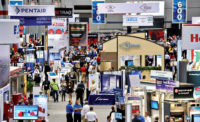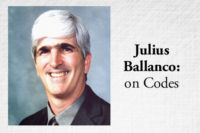Change is coming to the NFPA Expo this year.
The trade show returns to McCormick Place in Chicago June 22-25, but the National Fire Protection Association is putting on two new programs to keep industry members up-to-date on new changes to codes.
The first program will be a panel discussion series for NFPA 13 (the standard on sprinkler system installations) and NFPA 72 (the national fire alarm and signaling code). These two codes are both up for review and adoption.
“Attendees can learn what’s changing and why,” NFPA Senior Communications Manager Owen Davissays. “Each morning, a panel of Technical Committee members and NFPA engineers will explain the most important changes being made and share valuable insights into the rationale involved.”
The other new program will be new product presentations.
“These innovation sessions will focus on specific product areas, highlighting design advancements and emerging applications,” Davis says.
Davis reports that the Expo will feature more networking space on the floor, which will tie into the conference tracks. The NFPA expects this will make it easier during breaks to meet with other attendees who are interested in similar topics. Additionally, the show will have extended sessions to provide more in-depth information during the standard 90-minute sessions.
“We’re offering new ways for everyone to make the most of their time,” he says.
Other sessions available for fire protection engineers to attend include:
• “The Next Generation of In-Rack Sprinklers,” 8 to 9 a.m., Tuesday, June 23: This session will discuss the changes of extended coverage of in-rack sprinklers. The typical height of storage buildings has increased throughout the past 20 years and there has been a renewed demand for in-rack sprinklers.
• “Fire Risk Mitigation in Mission Critical Facilities,” 9:30 to 10:30 a.m., Tuesday, June 23: Fires in a mission-critical facility — such as datacenters or online businesses — could lead to business interruption costs that may be more than tens of thousands of dollars per minute, or a fire at an emergency call center may lead to loss of needed community services.
• “Design Strategies for Corrosion Control in Fire Sprinkler Systems,” 11 a.m. to noon, Wednesday, June 24: With many options to remediate corrosion-related failures in fire sprinkler systems, there also are multiple approaches that can be used during the design or commissioning phase of fire sprinkler systems that can reduce corrosion. This presentation will give practical examples that follow basic tenets of minimizing trapped water present in dry-pipe and pre-action systems, and minimizing the trapped air present in wet-pipe systems.
This article was originally titled “Ready to learn” in the May 2015 print edition of pme in the Fire Protection & Design Special Section.




